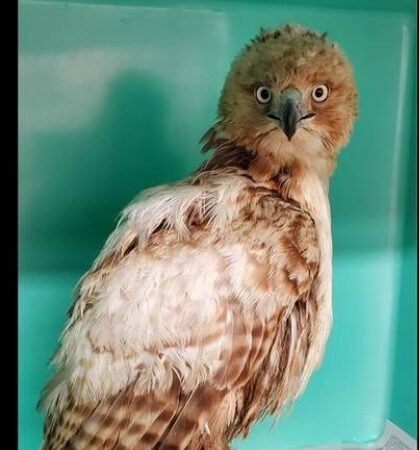
A strange-looking, oil-covered bird rescued in Pennsylvania turned out to be an exceptionally rare raptor, rescuers say.
A resident first spotted the bird, perched on a low branch for three days, unmoving, the Raven Ridge Wildlife Center said in a social media post. Seeing that it wasn’t going anywhere, the resident grabbed the bird with a towel and contacted a state game warden for help.
But it wasn’t clear to the caller, or to the game warden, what kind of bird they were dealing with, according to the wildlife center. With its unusual coloration, blonde and white feathers, the game warden’s best guess was a juvenile bald eagle.
“He called us to let us know he would be heading to our facility with the bird that was not able to fly or stand very well,” Raven Ridge said. “When the bird had finally arrived … we were all just stunned (by) the beauty of the bird when the Warden uncovered her.”
Rescuers cleaned cooking oil off of the bird’s feathers, which is what had left her unable to fly, the wildlife center said.
“She was hypothermic due to loss of body heat, and very thin and dehydrated,” the post said. “After she was stable and gained her strength back, she received a bath to remove the oil and is being hand fed until she is strong enough to feed herself.”
It wasn’t a bald eagle, but a leucistic red-tailed hawk, the center said. Though red-tailed hawks are common across the U.S., the bird’s color made it difficult to recognize.
Leucism is a rare genetic mutation caused by a lack of pigment, resulting in white feathers or fur, and has been documented in many different species, McClatchy News reported. While leucism is often confused with albinism, leucistic animals do not have the pink eyes and poor eyesight of an albino.
There are an estimated 2.6 million red-tailed hawks in North America, according to the American Bird Conservancy.
Of those, experts estimate only a few hundred are leucistic, outlets report.
“We feel that she is on the road to recovery and is making progress every day. We are hopeful for a full recovery and to get her back into the skies once again,” Raven Ridge said.
The Pennsylvania Game Commission has also taken an interest in the rare hawk, and has put a tracking band on her to monitor and collect information, according to the center. But they won’t get much use of it just yet.
“She will be with us for awhile until we can get her back to 100% of feeling better before she is released,” Raven Ridge said.
Raven Ridge Wildlife Center is located in Washington Boro, about 90 miles west of Philadelphia.




